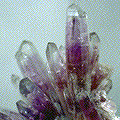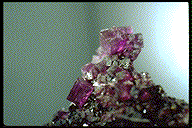MINERAL LOCALITY:
The Minerals
of Mexico
 |
 |
 |
 |
 |
 |
 |
 |
 |
 |
 |
 |
The reasons for inclusion of Mexico on the list of great mineral localities are many. At least sixty minerals claim Mexico as their type locality, meaning that they were first found and described there. In addition to silver, many other metals have been mined from here including gold, copper, iron, molybdenum, lead, zinc, manganese, arsenic and tellurium. Mexico has been mined for centuries dating back to pre-historic times and still is producing significant tonnages of valuable ores. An estimated 1/5 to 1/3 of all silver that has been recovered from the Earth has come from Mexico. The list of outstanding minerals from this country includes collector favorites listed here in no particular order: danburite, opal, grossular, apatite, rhodochrosite, topaz and other gemstones, legrandite, creedite, wulfenite, adamite (the best in the world), acanthite, pyrargyrite, boleite, silver, polybasite, stephanite and other silver minerals, fluorite, amethyst (the most expensive amethyst in the world), pyrrhotite, galena, rosasite, smithsonite, goethite, calcite (especially onyx), hematite, pyrite, hemimorphite, paradamite, mimetite, anhydrite crystals, cumengite, stibiconite, agate, gypsum (especially from Cave-of-the-Swords), cassiterite, scorodite, arsenopyrite, barite, etc, etc! And these don't include the really rare minerals! See the more complete table of Mexican minerals that includes the type minerals as well as collector favorites. Mexico has truly been a gift to the mineral collector.
The localities within Mexico are just as well know to collectors as the minerals that come from them. Place names such as Mapimi, Naica, Zacatecas, Boleo, Guanajuato, San Luis Potosi, Santa Eulalia, Sonora, Vera Cruz, Guerrero and Los Lamentos stir images of fantastic collection specimens. Some of these places are no longer producing the same amazing specimens while others seem to have new finds that exceed the last.
The silver
mines have their special place in Mexican mining history as well as a major role in the development of the history of the New World.
The mines of Zacatecas, Arizpe, Guanajuato, Pachuca, Batopilas, Fresnillo, Puebla and Taxco are
world reknown for rich ore deposits and well formed specimens of silver and silver sulfides.
The silver mines of Mexico have produced perhaps as much as a third of the silver that the world has ever used.
The silver wire specimens are fantastic and rival those from
Mapimi, in the state of Durango, is perhaps the most well known locality from Mexico.
It has produced the very best specimens of fluorescent
adamite (see above) as well as nice specimens of hemimorphite and
wulfenite.
Adamite is found at other localities around the world such as
Santa Eulalia, Chihuahua has produced beautiful specimens of creedite, calcite, hemimorphite, smithsonite, rhodochrosite and much more. Santa Eulalia is almost as prolific as Mapimi. The Potosi Mine in Santa Eulalia is one of the more productive mines in the area in terms of collection specimens. The rhodochrosite, from here was already famous when the discovery of beautiful purple creedite was made. Some creedite, had such a beautiful purple color with quartz-like clarity that they were originally mistaken for amethyst.
The state of Chihuahua in North central Mexico is also home to a wonderful mineral locality known as Naica.
At Naica, complex crystals of
fluorite adorn specimens of sparkling
calcite,
brassy pyrite and
silver colored galena.
Naica fluorites are quickly becoming classics among fluorite collectors.
They are perhaps the finest examples of fluorite's
The state of Sonora on the border with the United States just south of Arizona, is also well know for producing many nice mineral specimens. An extensive mining region exists in Sonora and is geologically tied to the same type of mineralogy as is in the mining districts of Arizona. Copper, copper compounds, silver and silver sulfides are abundant here. Tellurates from the mines of Moctezuma are quite unusual, having provided at least seventeen new tellurate minerals to science as well as specimens of many other tellurium minerals.
Baja California, the prominent peninsula on the pacific coast of Mexico is home to Boleo.
Boleo has produced some rare halide minerals such as
boleite,
pseudoboleite,
While lacking in some of the more precious
gemstone varieties, Mexico still does quite well for itself in the gemstone world.
Danburite
from Charcas, San Luis Potosi is world reknown and recently unearthed large clear crystals are easily found on the mineral markets.
Topaz
is also found in the state of San Luis Potosi and can be quite nice.
A variety of grossular known as "Raspberry Garnet" (pictured above) is found in Coahuila and is quite prized.
Another garnet gem found in Mexico is
andradite and forms iridescent green gemstones.
Another green gem is olivine and it is mined in the Chavira peridot-olivine mines in Chihuahua.
The famous apatite crystals
(pictured above) from Cerro Mercado, a productive iron mine, are prized for their clarity.
Outstanding opal of many different varieties is widespread in Mexico and occurs in pockets in volcanic rocks such as rhyolites and basalts.
Mexican precious opal is distinctive and makes a valuable contribution to the gemstone markets.
Fire
No discussion of Mexican minerals or Mexican gemstones would be complete without mentioning the not one, but two outstanding amethyst localities of Vera Cruz and Guerrero. These amethyst locations produce some of the most unique amethyst specimens. The Vera Cruz amethysts are often doubly terminated, prismatic, attached to matrix or free floating and clear with a pale lavender color. The Guerrero amethyst is much darker in color, prismatic, phantomed, tapering and majestic (see the picture above). The more affordable Vera Cruz amethyst is popular in wire-wrapped jewelry and as collection specimens. Guerrero amethyst is perhaps the most expensive amethyst in the world by weight and this is quite understandable as one look at a classic Guerrero specimen shows that there simply is no other amethyst like it.
It is a pleasure to write about Mexican minerals. The number of excellent specimens from this country is truly staggering. Mexico is easily placed with Brazil and the United States as the world's largest suppliers of collectable minerals. There simply is not enough space to discuss all of the wonderful minerals and mineral localities of Mexico. The unique igneous intrusions, odd geological events and arid to semi-arid environment of Mexico have thankfully worked together to produced this great mineral treasure trove. No collection should be without at least some specimens from Mexico. A full, but no doubt incomplete list of Mexican minerals is found in the Table of Mexican Minerals.
Much information for this page provided by the magazine "Rocks & Minerals", Vol 74; No. 1; Jan-Feb, 1999 and other sources.










